Photo Corners headlinesarchivemikepasini.com
![]()
A S C R A P B O O K O F S O L U T I O N S F O R T H E P H O T O G R A P H E R
![]()
Reviews of photography products that enhance the enjoyment of taking pictures. Published frequently but irregularly.
On Assignment: The Party


28 January 2013
Our assignment last Friday was to photograph a party hosted by co-workers in honor of a departing executive. The party was held at a newly-renovated restaurant very close to their offices.
In our earlier piece, we described what we packed for the shoot. Here we'll detail what we did at the event. In a forthcoming entry, we'll reveal what post processing we did to enhance the images and deliver the results.
If you have to take photos at an office party, or shoot a kid's birthday party or (heavens forbid) handle a wedding, take notes.
And the next time someone asks you to take a few photos at their event or you answer a craigslist ad for event photography that "should only take an hour," point them to this series. They just might appreciate a little bit better what you're actually going to do for them.
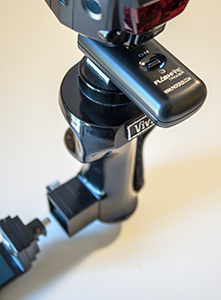
Vivitar Bracket. A sculpted pistol grip that snaps to the camera bracket. Note the FlashFire receiver under the SB-800.
IN THE BAG
Our description of the setup we used was a bit brief. We might have added a few more items that tend to come in handy, at least as insurance:
- Our famous wrist strap made from UPstrap components
- A spare set of four AA Eneloops for the flash (spares for the trigger would have been a bright idea, too)
- A second memory card
- A lens cloth
We might also have mentioned the camera and lens, but we've used an assortment of gear for things like this. When we've wanted to be unobtrusive (a guest among the guests), we've even used a small digicam to record a participant's view of things. But in this case, we were there to document the proceedings.
Because the party was being held in a room at a restaurant we knew we needed a wide angle zoom. The typical kit lens is just perfect for that, in fact.
The spare batteries and card and lens cloth all fit in the Domke's front pouch. The flash and camera fit in the main compartment and the broken-down bracket fits in the side car.
We also pack a white shower cap in the Domke in case we have to use a camera's popup flash. That by itself is a great diffuser.
So in a small shoulder bag we had about three lighting solutions for whatever situation we were about to find ourselves in.
With freshly charged batteries and after confirming our camera and strobe setup for ISO, aperture and shutter speed, we were ready for action.
SETTING THE SCENE
We dropped by the office before the party to take a few shots of the familiar. We took photos of the sculpture outside, the company logo at reception and the departing exec's office, too.
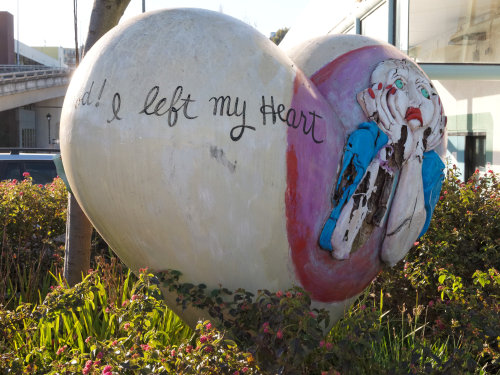
Setting the Scene. We took a few of these around and in the office.
Then we made our way to the restaurant, taking a shot of the exterior before we went in.
THE VENUE
It seems to be a law. Whatever room a party is held in always presents difficult photographic problems.
In this case, we wanted to know what kind of light we should use. None, a little or rely on our strobe entirely.
The room itself was in a marvelous location, with a view of San Francisco Bay. But that mesmerizing view was seen through two adjacent walls of large windows. That presented two problems. Before dark, the outdoor sky would backlight every shot. And after dark, the windows would reflect any flash thrown at them.
The ceilings were very high and painted a dark blue, like the walls. So we weren't going to get any help boosting the bounce light.
Because of the backlighting, we couldn't shoot with natural light in the fading light of the afternoon and evening. Using the onboard flash might have been tempting as we navigated through the crowd of people, but we really needed more power than that and less red-eye.
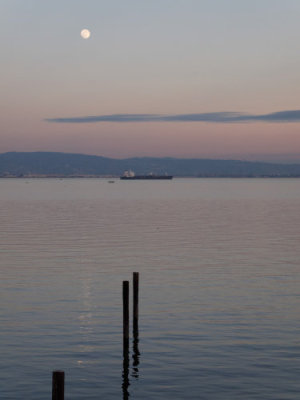
Ambience. It was a special spot.
So we setup with the SB-800 strobe on the Vivitar bracket. We'd shoot flash for everything except video.
THE SCHEDULE
It helps, even with an informal event, to find out who's in charge and what they have planned.
We learned that, after everyone had arrived, there would be a short presentation and then back to socializing.
THE SMARTPHONE
We weren't the only camera in the room, of course.
Some photographers get unpleasantly proprietary about the occasion, warning anyone with a camera not to intrude on their shots. They have legitimate concerns like some other flash firing in the middle of their shot or lost print sales.
But that's not really how to make friends and influence people.
In fact, when we saw someone with a smartphone taking photos of friends, we smiled. He knew the crowd, who was who, and he got them together for some nice candids.
He was, however, having a little trouble with the light in that room. And his LED flash wasn't much help. In fact later, when he asked about our setup, we were happy to explain how it solved the problems in that room, which was certainly big enough for both of us.
If you feel otherwise, the solution is pretty simple, really. Just leave.
PRESENTATION
When the master of ceremonies called for everyone's attention, we were ready for him.
He gave a long speech reading a stack of certificates that bestowed a bevy of humorous (if dubious) benefits on the departing exec. We handled those with a few stills. Later we remembered to shoot a closeup of some of the certificates.
When a second person got up to make a presentation, though, we switched to video. He told an amusing story and we're glad we caught it on silicon. We were lucky, though, because he told us he was going to tell a funny story.
It pays to listen, too.
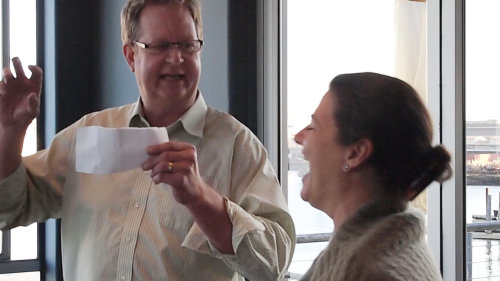
Video. Just a frame here, which we included in our stills collection.
SETTINGS
Part of the magic of covering an event like this is setting up the camera so you don't have to think about it, no matter what changes in the room.
The first decision was made long before we got to the restaurant. Which ISO to use. We decided on 400 to prolong battery life in the strobe and get a bit more depth of field than 200 but still be safe from noise in the shadows at 800 or higher. ISO 400 is a very safe place to be for this kind of shooting.
Setting ISO 400 on the strobe told us to use f5.6 for an aperture. The strobe would meter the light itself, not through the lens, which works fine as long as you keep the strobe and the camera roughly the same distance from the subject.
Setting the shutter speed (in Manual mode) was really only a question of looking up the maximum sync speed in the manual. In this case it was only 1/125 of a second. Not very fast, but certainly quick enough to prevent motion blur as people waved their arms, chatted or laughed. And not bad for capturing the afternoon light on the bay in the background of some shots.
Autofocus, yes. Face recognition, yes.
But there's one more important setting to check before you start shooting. When we have a difficult venue like this one, we like to shoot Raw+JPEG rather than just Raw or just JPEG. The JPEG is a handy check on the image but we end up working with the Raw images to develop the shadows and preserve highlight detail. We generate a much better JPEG final image than what comes out of the camera.
But for an outdoor sporting event, say, JPEGs would have been just fine. And would have let us shoot a few more frames per second, too.
In this case, the room made that decision an easy one. We knew we'd need the Raw data to make up for the lighting limitations.
SHOOTING
Taking stills with our setup is pretty simple.
We put a diffuser on the strobe and angled the head 60 degrees, which gives you the most efficient diffused output.
We could hold the strobe two ways.
Our preference is to detach it from the bracket that screws into the tripod socket on the camera, holding it in our left hand away from our body. That lets us aim the light independently of the camera. That's a lot of help when you have someone standing between the strobe and the subject. You can just lift the strobe over their head to get the light there without creating a shadow that falls on your subject.
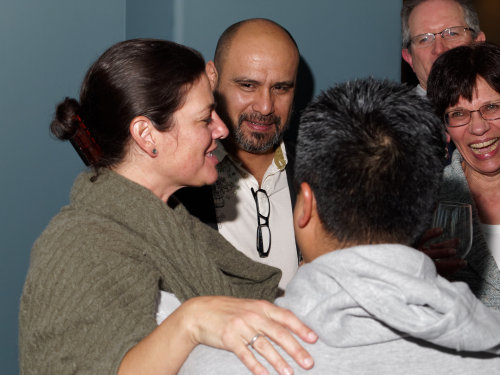
Floating Strobe. We held the strobe high to drop her shadow below the face of the fellow standing next to her.
But we could also attach the strobe's grip to the bracket. That frees our hand to control the zoom. For the most part, we prefer to find a focal length that works for a shot of three people and step forward for two and back for more, not zooming but using the lens as a prime. But when you have to zoom, you have to zoom. And being able to dock the strobe on the bracket is a big help.
SPECIALTY SHOTS
In addition to setting the scene and taking random shots of people enjoying the party, there are a few special shots to consider.
That video was one. It's a great way to capture a toast or a short presentation. But don't overdo it or you'll spend months working on the video afterwards.
Posing people in small groups is another favorite. "Over here!" people called to us. "Can you take our picture?" Sure! Posing without prompting? That's a blessing for any photographer.
And finally there's the group shot. Which, frankly, is always a series not a shot. Someone will blink, someone else will look away, someone will be laughing. By taking a series of them (quickly but with enough time for them to recover their pose, perhaps by shouting, "You, over there, don't blink!") you'll manage to get each person looking just fine in at least one image. Which will be their favorite.
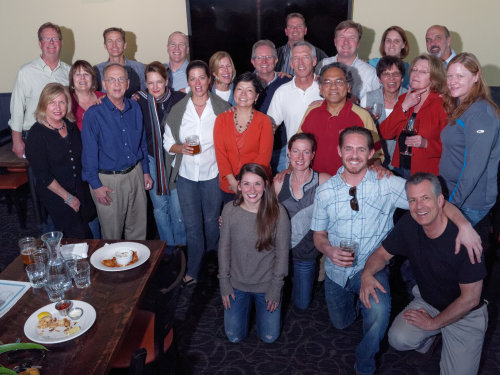
Group Photo. One in a series. See why we took more than one?
The group shot can make a nice large print, too, that everyone can sign. In this case, there was no call for prints. But it's a nice thing to keep in mind.
We also like to take an occasion shot of what people might have been looking at now and then. Capture the ambience, in other words. Like that shot above of the moon rising over the bay. It's also a nice break from shooting with the strobe.
OUTPUT
This was an intimate gathering but for a larger group, it might have been fun to set up a table to wirelessly receive and display images from the camera (using, say, an Eye-Fi card in the camera and Eye-Fi's iOS app on the tablet or some such arrangement).
But everyone knew each other and were engaged in conversations so it would have been more of a distraction than an entertainment.
We did, however, briefly set the camera down on a table and leave it on so people could take a peek at the shots. More than one person knows how to press the Playback button and use the arrow keys or even the Menu button to get to a slideshow.
WRAPPING UP
Don't be in a hurry to leave.
As people are leaving, put a few business cards on one of the tables near the exit. And give one to anyone who asks for copies of the photos.
Hang around until the end before you put the camera away. There's no advantage to doing it too soon. That's a good way to miss shots. And sometimes the good-byes are among the best images.
NEXT
We sometimes share the images during the event, as we said. And sometimes share them right after. If you're selling prints, you'll want to get the thumbnails up as soon as possible because orders are driven by the freshness of the event.
But for something like this, there's no urgency. It can be quite a bit more enjoyable for the participants to see the images after they've forgotten the details of the event and come back down to earth.
And in this case we had a "little" work to do on both the stills and the video anyway. In our next piece, we'll detail what we did to finish the job. Stay tuned!